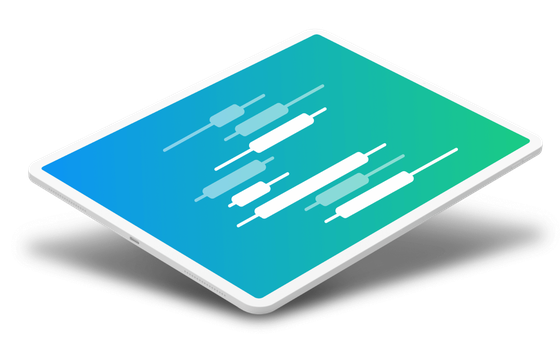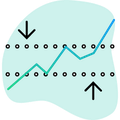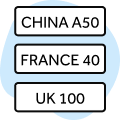Our pricing
Market volatility and market liquidity are two primary factors that affect spreads. Trade execution is fully automated and is built around our principles of fairness and transparency.


Spread-only pricing
With this account type, our commission is wrapped into the spread we offer so the spread is the only cost you must pay.
Commission + core spread pricing
Access a reduced spread relative to our spread-only pricing account. You only pay a fixed commission per trade. The total cost for each trade will be the sum of the applicable core spread plus commission. Our core pricing spreads start from 0.0, with $3.50 commissions per 100,000 volume.

How our pricing is derived
Our pricing is derived from liquidity providers (forex and metals), futures contracts (commodities, bonds and copper) and futures prices in relation to the index (indices). When the markets are moving, your orders are filled at our best available price.
Commission + core pricing vs spread-only
View our core pricing on our most popular FX pairs.
| FX pair | Spread-only | Core pricing |
|---|---|---|
| AUD/USD | 0.7 | 0.2 |
| EUR/GBP | 0.8 | 0.2 |
| EUR/JPY | 0.9 | 0.2 |
| EUR/USD | 0.6 | 0.0 |
| GBP/JPY | 1.3 | 0.5 |
| GBP/USD | 0.9 | 0.2 |
| NZD/USD | 0.9 | 0.2 |
| USD/CAD | 0.7 | 0.2 |
| USD/CHF | 0.8 | 0.2 |
| USD/JPY | 0.6 | 0.2 |
Forex and metals CFDs
Our pricing for forex and metals CFDs is derived from our liquidity providers - major financial institutions who provide us with available spot pricing for FX pairs and metals. These prices are analysed by our automated pricing system to generate our mid-point price for each FX pair and metal CFD. Different groups of liquidity providers are used to derive pricing for different products/instruments.
For unusual FX pairs, we may derive the price from two major/minor currency pairs. For example, the price for the Singapore Dollar/South African Rand FX pair may be derived from the USD/SGD and USD/SAR FX pair prices.
Indices CFDs
OANDA's index prices are calculated by reference to a combination of the relevant futures price and the 'cash' or 'spot' price in respect of the underlying reference product. Adjustments may be made to reflect market movement following the payment of dividends and other anticipated corporate actions.
Commodities, copper and bonds CFDs
Prices for our commodities and bonds CFDs are derived from futures contracts in relation to the commodity or bond. The price shown for trades (positions) in commodity CFDs is not a direct reflection of the futures price for that commodity. Instead it is based on the futures market price for that commodity plus a discount or premium.
Our automated pricing system receives futures pricing feeds from relevant futures exchanges.
Prices for our copper CFDs are derived in the same way as our commodities and bonds instruments.
Ready to start trading? Open an account in minutes
Already have a live trading account? It's easy to fund your account using one of the following payment methods.





Frequently asked questions
What are financing costs?
Find out how financing costs are calculated.
What is a corporate action?
Constituent stocks of an index will periodically pay dividends to shareholders. When they do, this impacts the overall price of the index, causing it to drop by a certain amount. We may make dividend adjustments if a dividend is scheduled to be paid to the holders of the underlying instrument. These adjustments are normally made on the ex-dividend date.
How would dividend adjustments work on open positions of index CFDs?
When there’s a dividend payment, this is normally reflected in the index CFD price. If you have an open position at the time of a dividend adjustment, we’ll ensure that there is no material impact on you by either crediting or debiting your account with the same amount that your unrealised profit and loss has been impacted.
For example:
For long positions:
Let’s assume UK100 (FTSE) is trading at 7,167.95 GBP. If a client is long 20 units of UK 100 and a stock in the index pays out a dividend that equates to 5 index points.
The index value would drop to 7162.95 GBP.
The dividend adjustment would be
= index dividend points X no. of units of the index CFD held
= 5 X 20 = 100 GBP
This will be credited to client's account post home currency conversion.
For short positions:
Let’s assume US SPX 500 (S&P500) is trading at 2,989.69 USD. If a client is short 10 units and a stock in the index pays out a dividend that equates to of 0.890 index points.
The dividend adjustment would be
= Index dividend points X no. of units of the index CFD held
= 0.890 X 10 = 8.90 USD
This will be debited from client's account post home currency conversion.
Clients will be able to see OANDA's dividend adjustments in their Transaction History and Statements.
Can’t find what you’re looking for?
*Voted Best Broker 2023 (TradingView Broker Awards 2023). Most Popular Broker 3 years in a row (TradingView Broker Awards 2020, 2021, 2022).
^Execution speed and numbers are based on the median round trip latency from receipt to response for all Market Order and Trade Close requests executed between January 1 and May 1, 2019 on the OANDA execution platform.

Trade forex CFDs
Take a position on over 70 forex CFD pairs using our OANDA Trade platform and MT4 and TradingView.
What are financing costs?
Financing costs can affect your cost of trading, so it's important to understand how financing works.
Our spreads and margins
For retail clients, our margin rates start from just 1% on EUR/USD and GBP/JPY.




